#creative modular ot
Explore tagged Tumblr posts
Text
The Future of Modular Operation Theatres in India
Portable operating rooms in India will thrive as healthcare needs rise. These venues' manufacturers invest in R&D to identify better materials and technologies to improve performance and durability. Sustainable materials and energy-efficient solutions are increasingly gaining popularity. Telemedicine will also transform surgery by allowing doctors to communicate and collaborate remotely. Modular operating rooms are improving, making India's healthcare system more efficient and patient-centred.
Conclusion: Indian companies producing modular operating rooms are driving significant healthcare transformation. Flexible, efficient, and high-tech surgical rooms improve medical institutions and patient care. Innovation, sustainability, and personalisation will shape surgical environments in the future, improving national health over time. Choose Creative Health Tech Private Limited for any raw materials for operation theatre.
#creative modular ot#modular ot#modular operation theatre#ot control panel#ot lights#hospital equipment
0 notes
Text
ARCHIZOOM ASSOCIATI
Around 1966, settle in one of my favorite cities, Florence Italy, a group of students named Andrea Branzi, Massimo Morozzi, Gilberto Corretti and Paolo Deganelo -in 1968 two more members, the Bartolines joined the group.- They had just finished architectural school but at the time, there was a lack of work and a general stagnation of the architecture profession. Also these years in Italy were marked by an economic downturn, housing shortages, and governmental fumbling.
This architects came together to form groups of design vigilantes known as the “Italian radicals” that their work critiqued modernism and promote consumerist style-driven societies.
Sotsass introduced Archizoom to Poltronova. These produced a series of projects in design, architecture and urban visions, “they inspired many young architects to reassess the intellectual input of their personal creativity while denying the technological input in open criticism of consumerist society.” (Raimondi, G., 1990)
Archizoom came to prominence through an anti-consumerist exhibitions named “superarchitecture” which consists in a pop style in architectural and design development. They broke the conception of traditional good design by applying irony in the creation of kitschy gazebos and environments that undertook the critical destruction of functionalist heritage and the spatial concept of modern movement.
They created the “Superonda” sofa launch in 1966 that consists on a sinusoidal line cut from a polyurethane foam block and covered in shiny leatherette. They come in white, red or black colours. This was one of the first sofa without an ordinary frame. Super onda was designed to challenge the middle class restraint.
“Like all the objects designed by Archizoom, it aims to inspire creativity and imagination (...) it effectively shown a manifesto of italian radical design by its modular character and lightness that allow its usage to be changed at will; it can be a bed, a sofa or a chaise longue.” (Centrostudiopoltranova, n.d)
Archizoom in 1967 created the “Safari” sofa, consisting of a fiberglass structure with a seat and back of polyurethane, upholstered in fake leopard skin fabric. Its modularity allows it to be joined as a sofa or an armchair.
This sofa refers to the kitsch design and Pop Art. Its modular format provides a new domestic landscape that stimulates creativity and individual imagination.
The safari sofa and the superonda were furniture that demonstrated an uncontrolled eclecticism. “These objects are based on their essence as image and status objects rather than as objects, and were born in controversy with the fashion of super-padded furniture, symbols of well-being, opulence, distinction and good taste.” (White, R & Donohue, D., 2013)
In 1967 they came up with the “Dream bed” “that give life to hybrid and ironic environments with strong citations from kitsch and Islamic or oriental patterns, with the aim to spoil the optimistic vision of bourgeois progress.” (White, R & Donohue, D., 2013)
Archizoom culminates with the anti-design movement in 1969 "No-Stop-City," one of the most mysterious and radical visions of the future cities, an ironic urban plan with a highly artificial environment consisting in no borders, artificially illumination and air-conditioned that takes modernist ideology to an extreme. In order to make it popular and to get people feel attracted, Archizoom created multifunctional furniture and clothing for the inhabitants.
By the end of their activity, around 1974 Archizoom achieved an all-embracing creation, reaching from object to clothing, from furniture design to large scale urban proposals; a heritage transpiring the passionate ideals of a generation believing in a humanity liberated of the constraints of architecture, fighting for alternative cultural concepts, hoping for a nonconformist lifestyle and total freedom.
REFERENCES
Centrostudiopoltranova, (n.d) Superonda, from the web: http://www.centrostudipoltronova.it/portfolio_post/superonda-3/#
Pamono, (2017). Superonda Sofa, from the web: https://www.pamono.com/superonda-sofa-by-archizoom
White, R & Donohue, D., (2013) Networks of Design, Florida, US: Boca Raton, digital in https://books.google.it/books?id=3B5bbv0r-EkC&pg=PA101&lpg=PA101&dq=dream+bed+archizoom&source=bl&ots=BHFUrRGMZ2&sig=IMR6phDKCzgmqKsA1eoDWFa4NUk&hl=es&sa=X&ved=0ahUKEwj2vvODk9zWAhWMJsAKHR1QA4AQ6AEIdDAO#v=onepage&q=dream%20bed%20archizoom&f=false
Raimondi, G. (1990). Italian Living Design: Three decades of interiors, Rizzoli
1 note
·
View note
Text
Project 1 Planning: Grids
As seen, in the screenshots below, I chose to stick to my three original choices of typefaces Gill sans, BaroqueTextJF, Mason Sans OT. I also wanted to retain the black background for my poster as it gives it a more dramatic look.
1) 3 column grid
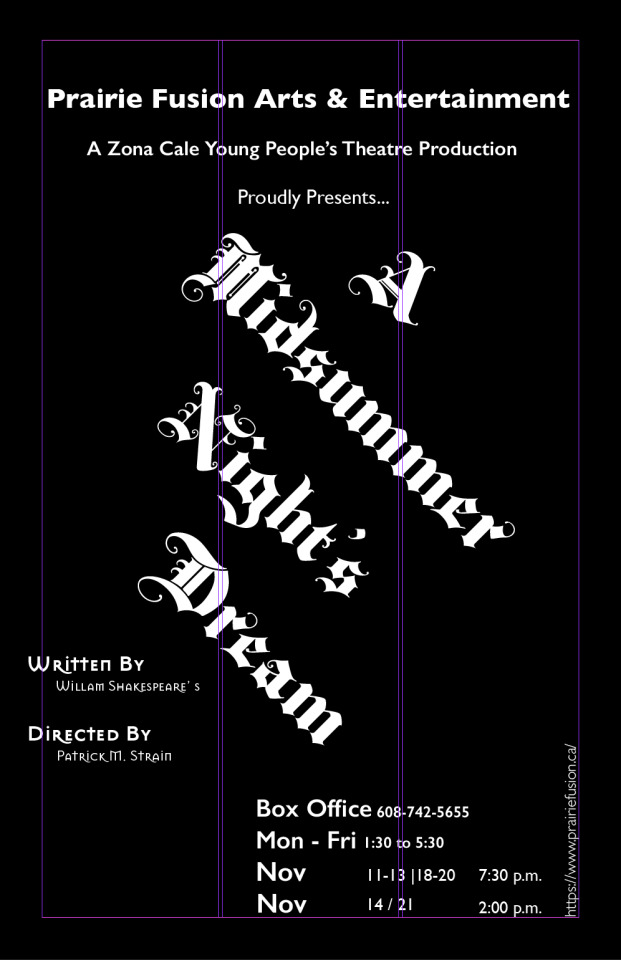
For my first design I wanted to push my limits and just play around with all the elements of my poster, by rotating the title to a different angle than a straight 90 degree angle, positioning the link vertically on the side of the poster to show more variety and contrast in design.
2) 5 column grid
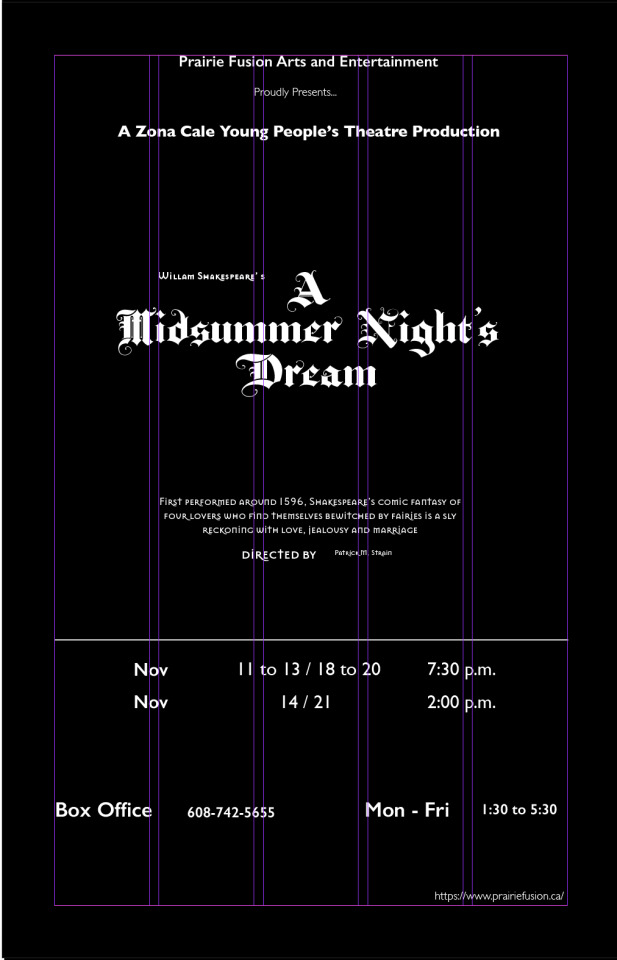
For this I I flipped it and made it more structured and designed. Moreover, I placed everything in such a way that there’s a lot of breathing space for the reader, hence, there’s a sense of neatness, organization and hierarchy. Thirdly, I added in some additional text for the poster so that there’s some information on what the play is basically about.
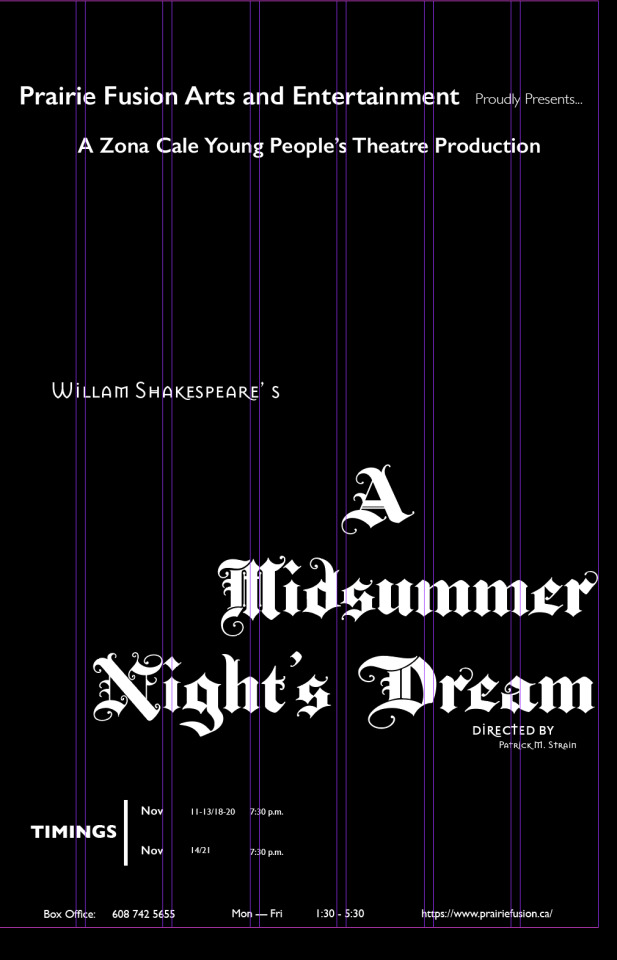
In this design there’s a larger sense of contrast and breathing space. The content here is laid out more towards the bottom of the poster rather than the centre. This makes it more interesting to look at.
3) 5x7 Modular Grid
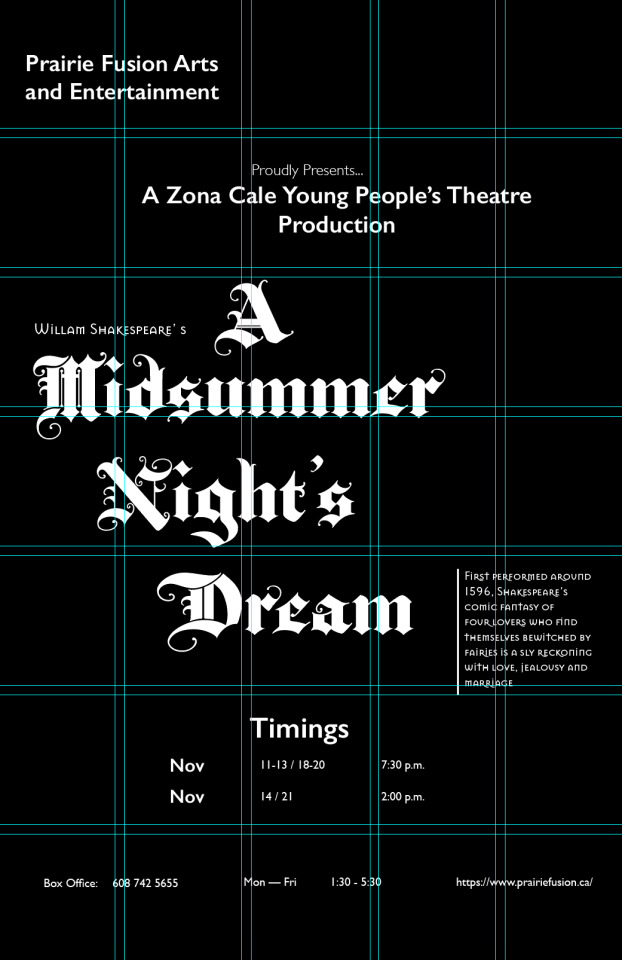
In these last two designs I decided that it would be better to incorporate the little synopsis of the play to give our viewers some information as what it is all about.
4. 8x10 Modular Grid
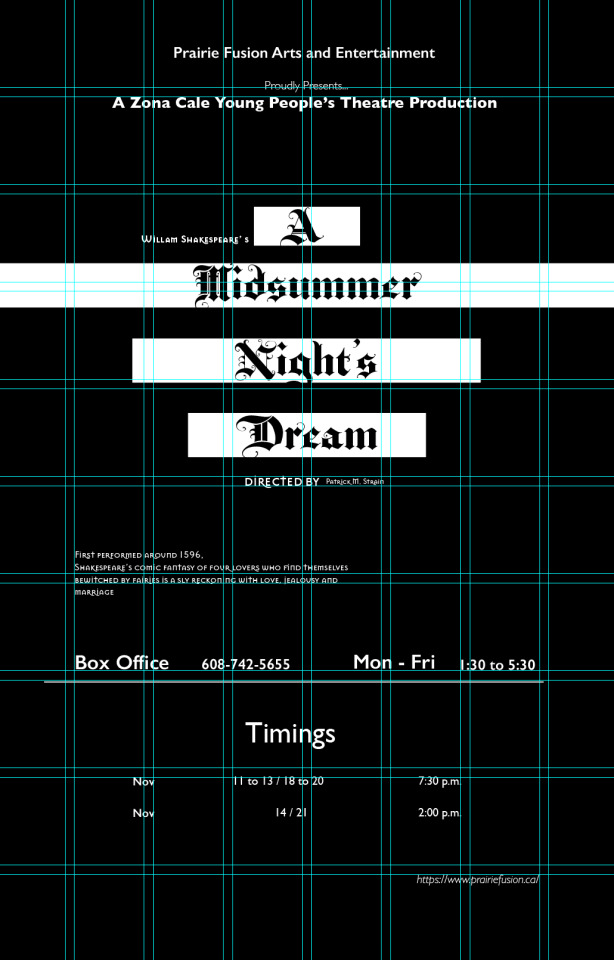
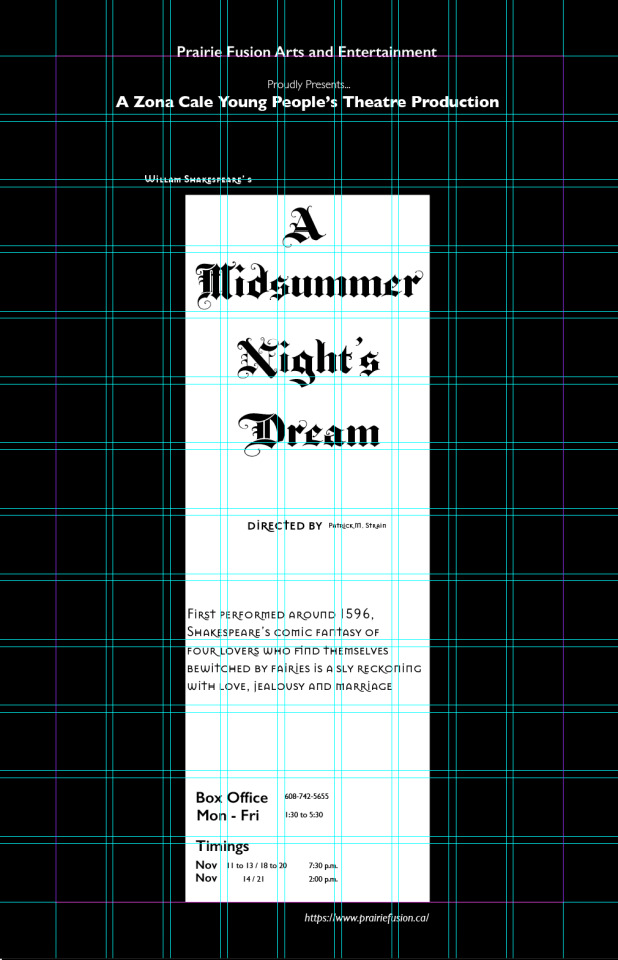
This was a bit challenging however, it gave me the opportunity to explore my own creativity skills! Hence, after experimenting with a variety of designs, placements, alignments and grids I came to the conclusion that I would use a 5x7 grid for my poster document.

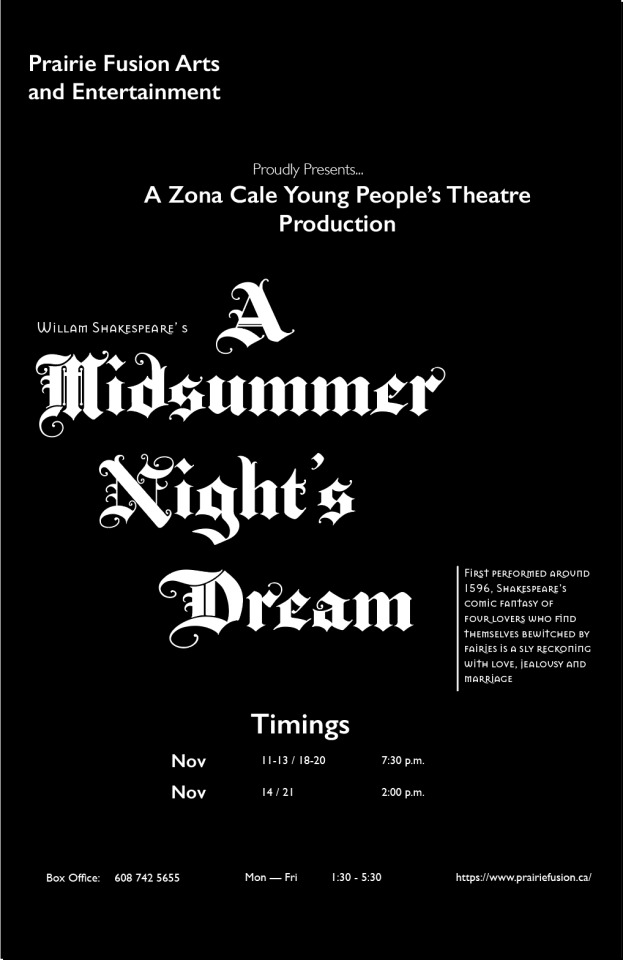
Hence, I chose this as my Final grid and design for this play’s poster! I felt this was the more dominant design as it clean, clear and straightforward. This poster easily draws the viewer in by the bold title and then to the synopsis of the play and the timing and so on. Therefore, there's a sense of hierarchy and structure. It’s readable and legible. Even though BaroqueTextJF may be a dramatic typeface, its easy to read while being interesting enough to draw in the audience. Moreover, the design incorporates an even amount of white space / breathing space which avoids overcrowding .
0 notes
Text
Soundrs: Ben Eyes

Welcome to our new Friday feature: #producer #interviews The focus lies on #workflow & #inspiration, in order to provide a way to both gain insight about #music #production and spotlight ambitious #audio #producers. If you want to get featured, send a message here on #tumblr or an email to [email protected]. The questions will remain largely the same. Now let’s get the ball rolling with our first of many Soundrs! Indulge.
Ben Eyes is a sound engineer, composer and live performance artist based in Leeds, UK. He makes electronic music as Quip https://soundcloud.com/quip and is one half of percussion and electronics duo STOCKER/EYES https://stockereyes.wordpress.com/
• What are your inspiration sources?
Sometimes field recordings, sometimes instruments I find new corners of gear I haven't explored. I am a bit of a gear hoarder, but old 80/90s stuff as opposed to new shiny things. I love the Kurzweil K2000 its full of 80s/90s sounds but then you program it and get something contemporary, its Max MSP in hardware. I like to explore timbres and rhythms together so that might be having a drum pattern distorted in a cheap fx pedal or using delay to create new rhythms. I am a sucker for the Roland 707 as my main drum machine but the sound of it gets twisted and messed up. I find the grooves I create with the old drum machines feel more planted and make me want to dance, if that’s what’s needed.
• Tell us something about your workflow.
It is sort of split up into 3 really, I am really lucky in that I have a large room in my little (detached) house, I live in the middle of nowhere so I don't disturb anyone. I have a guitar corner with all my effects and amps setup. Then a keyboard stand with all my drums and synths near to hand - I stand up at this and get grooves and patterns down using hardware. Then a computer and mixer next to each other. I have a bunch of synths on my computer table too. I love tabletop synths so you can just sit and noodle. I tend to get something going on with a couple of synths and a drum machine. Increasingly its a small euro rack modular that i have been building. Everything is synced together and clocked from the 707, but I do some weird things with syncing - I get a 606 to do irregular clock from the tom outputs - this provides sync for the modular and a Korg electribe, which I still use alot and have a load of sample banks for it on SD cards, it makes some messed up horrible sounds and also some very punchy drums. This gets the juices flowing. I will record the jam into Ableton then start chopping or adding stuff. I like to use a mixture of analogue and digital. Posh and poor. So I might use the Pro One with a Casio keyboard but through a decent effects pedal. I think having lots of different sources in a track helps to make the sounds interesting. I started out with nothing, a four track and a delay pedal as a kid. Then a computer a bit later. I ran Rebirth and Cubasis, putting everything together in a sequencer. So having this studio is a complete luxury, a dream really. I managed to get this studio together by working my arse off and getting bits second hand every now and then. I am quite strict about not buying new stuff, there is too much gear in the world so I try and get a bargain now and then. I am a sound engineer by trade so I get offered kit quite a bit. The internet has helped also. My room is pretty full now though so its just a question of me getting time in here to work. I have a couple of different monitor options and a sub which is great. To be honest I keep things really simple. The main thing I guess is I use hardware almost 100% now. Some software compression and EQ but its all sounds from boxes, guitars or my mouth.
• How would creative rituals benefit your workflow?
Well I used to smoke a bit and have a drink to get in the zone, which I have stopped now. I just drink tea. Have a meal with my girlfriend and then get into a flow. I like to loop weird things I might have recorded in my job or just play with a machine until something comes out. Rituals are really important. I cycle a lot and love mountain biking. Also just playing the guitar and using acoustic instruments helps. I have a tonne of guitars and little stringed things. Acoustic instruments are ritualistic, they are the maddest things really. The more I think about a guitar the more it drives me to create something with it.
• How do you get in the zone?
Just relaxing, not thinking too much. I do quite a bit of music to spec, and also study at the moment for PhD in Composition at the University of York. This means I have to switch off really when making "my music". I just use music to relax often. As a way to create something that might be heard somewhere. I gig less now and don't release music much so its more of thing for myself and occasionally others.
• How do you start a track?
Sometimes I setup a load of gear and just go for it. If I have a load of tracks to do for a record I just get three or four boxes going together, maybe drums and two synths then hammer out a load of improvisations. I like to work quite fast so I will stay in this mode for a while. I don't use a pool of samples so every time I start a track I try and record new stuff. Thats probably crazy but it keeps things fresh and I always find out new things. I might have one or two loops from my recorder or phone but usually every things done in the studio.
• Do you have a special DAW template?
No I am not really into that. I have fave effects settings on hardware. Everything runs through a desk in the studio so I just patch in whatever I want and go. It takes 1 second to add a channel and assign an input. I use my whole studio like a template really. So certain FX for certain instruments. Then when I get bored I repatch. I have two patch bays pretty much full so they get used a bit.
• What do you put on the master channel?
Nothing until the end then its an SSL bus compressor or the Fab Filter compressor and a limiter. Maybe a tiny EQ but nothing crazy, I like to hear the dynamics till the very bitter end. Luckily my room is flatish so I can work quite confidently in there.
• How do you arrange and finish a track?
Walk away and come back the next day, then keep snipping. I used to be terrible at editing and getting rid of things but now I am quite ruthless. Its funny how you change over the years. I'll listen to things and think fuck thats terrible it has to go. Come in the next day and get rid. I think thats part of being much more sober now when I make music and more of an idea of what I want. Quite often I have the arrangement in my head so I just snip away. I do automation by mouse and sometimes enter some fx with a MIDI controller. But usually my tracks aren't huge so its quite a simple process.
• How do you deal with unfinished projects?
Every few months I might have a train ride or a hard disk sort. I will go through old stuff and highlight them and try and finish them. I have an album I have just finished that was made like this. Just going back to old stuff until it was finished. I'm really happy with it should be out soon as I am mastering it currently.
• How do you store and organize your projects?
Hard drives - I don't tend to store things on the local disk. Then back up the disks, then back up those. Then the cloud too. Mixes get sent there. I am quite good at backing stuff up at the moment.
• How do you take care of studio ergonomics?
Have separate places in the studio to do stuff, guitar and bass corner then a drum machine/synth section then my computer/desktop synths and mixer. Everything's quite divided up. I love my desk at the moment - it has all the desk top synths and volcas and the mac, so I can just record a groove from synth / drum machine world then sit down and add a nice synth, the TG-33 gets used or an old Novation Nova and edit.
• Tell us something about your daily routine, how is your day structured, how do you make room for creativity?
I work a lot either at the University where I look after the studios and do teching for concerts and I work freelance mixing for bands such as Wrangler, who are quite a heavy live electro band. They tour a bit so I go away a lot. I have been getting into iPads for sketches. I have an albums worth of stuff done on it. Just need to mix it. So yeah I watch and listen to others a lot - recording or mixing live and in a way you get ideas this way for your own stuff. Always learn even when its other peoples work.
• Share a quick producing tip.
High pass filter everything.
Try and make space for everything in the mix by filtering. Don't boost too much.
Don't worry about all the gear. Just get the idea down and it will go from there.
• Share a link to an interesting website (doesn’t have to be music related).
I'm reading this at the moment. I love stories of creative friction, fights between creative people are always interesting because people really feel this stuff. Also I am a member of an institution and I see my own politics and watch the institutional bullshit from a distance. I am lucky enough to have worked at EMS and it's a great place. This is quite eye opening if you are into art politics.
https://books.google.co.uk/books?id=i7W9CwAAQBAJ&pg=PA169&lpg=PA169&dq=music+box+software+ems&source=bl&ots=5FbKkMKKgt&sig=Zr7Y5pJCvWn7N4HtJbjkgPQz8m8&hl=en&sa=X&ved=0ahUKEwi6uLj1q5XWAhUMXhoKHaInBQoQ6AEILzAB#v=onepage&q=music%20box%20software%20ems&f=false
• List ten sounds you are hearing right this moment : )
I am recording a band called Roller Trio. Jazz electronics. So I am hearing reverse guitar, bass, sax, acoustic and real drums, the hiss of the mixer, 808 samples and occasional pop of an old sound card ;-)
#music#House Music#musician#digital music#rap music#techno#techno music#technomusic#audio#audio production#audio equipment#audio producer#audio gear#Sound Design#Sound#soundcloud#sounddesign#soundrooms#soundr#soundrs#recording studio#studio#home studio#music studio#synths#synth#synthesizer#analog synth#modular synth#interview
11 notes
·
View notes
Text
Top 10 Hospitals in India for Overseas Patients travelling from Abroad
India ranks among the best destinations for medical tourism in India. With best infrastructure, hospitable services, economical costs and a plenty of options, medical tourists from all over the world choose to come to India. The popular names of Medical Tourism Hospitals in India for Advanced Treatment make India stand out amongst the rest of countries.
1. BLK Super Specialty Hospital, Pusa Road, New Delhi
BLK Super Specialty Hospital provides services to people of all ages. However, the fact that draws the attention is that the hospital has reserved 125 beds out of the total 650 beds for the ICU. The prime destination features state-of-the-art technologies which are put to use by reputed personalities in the medical industry. With the outpatient services extended up to two floors, the hospital is one of the largest tertiary care private hospital.
Facilities – Modular operation Rooms, electronic security system, modern fire-management systems, medical record transfer, online doctor consultation, personal assistance / concierge, private rooms for patients’ available, special dietary requests accepted
Specialties – Anesthesiology, Ayurveda, Bariatric and Adv. Laparoscopy Surgery, Dental & Maxillofacial Surgery, Dermatology, Emergency & Acute Care Medicine, Endocrinology and Endocrine Surgery, ENT & Cochlear Implant, External Counter Pulsation, General and Minimal Access Surgery, Gynecology & Obstetrics Hepato Pancreato Biliary Surgery etc.
2. Fortis La Femme, Greater Kailash, New Delhi
Fortis La Femme Hospital efficiently meets the needs of females seeking for best medical care. Working on a common belief that a woman is very special person with special need, the hospital proffer services for every stage of woman’s lifespan. Female patients from abroad can approach hospital’s international travel agency for any help required. From finding airfares to currency exchanges, everything is taken care of! The hospital won the award of Most Popular Maternity Hospitals in the year 2013 for providing quality care services.
Facilities – Genetic & Foetal Medicine, Advanced Diagnostics (Ultrasound, Mammography & Bone Densitometry), Mamma Mia: Wellness, Fitness & Education for New & Expecting Mothers, A variety of rooms to choose from, Cafeteria, Gift Shop
Specialties – High Risk Pregnancy Care, Advanced New-born Care (NICU), Minimal Access General & Gynecological Surgeries, Fertility Clinic & IVF, Aesthetic & Cosmetic Surgery etc.
3. Columbia Asia Referral Hospital, Yeshwanthpur, Bengaluru
Columbia Asia Referral Hospital is known for giving services in various countries like Malaysia, Indonesia and Vietnam and has spanned across India as well. The first hospital in India began functioning in Hebbal – Bangalore in the year 2005. With a mission to provide the best clinical outcomes in most efficient, effective and caring environment, the hospital has a passion of making people better. The staff is handpicked carefully, trained properly and rewarded handsomely.
Facilities – Histopathology, Clinical pathology, Cytology, Biochemistry, Microbiology, Pathology, 24 Hours Cafe at Ground Floor, Out Patient Cafe at 4th Floor, Inpatient dining, Speech Therapy, Swallowing Therapy, Voice Therapy
Specialties – Anesthesiology, Bariatric Surgery, Cardiology and Interventional Cardiology, Cardiothoracic and Vascular Surgery, Critical Care Medicine, Dermatology, Emergency Medicine, Endocrinology, ENT, Head and Neck Surgery, Gastroenterology, General Surgery, Infectious Diseases, Internal Medicine, Liver Transplant & Hepatic Surgery, Maxillofacial Surgery, Medical Oncology & Clinical Hematology, Minimally Invasive Gynecology, Psychiatry, Pulmonology and Sleep Medicine, Renal Transplant, Rheumatology, Surgical Gastroenterology, Urology, Vascular and Endovascular Surgery etc.
4. VPS Rockland Hospital, Dwarka, New Delhi
With a renowned network of 19 hospitals in UAE and Oman, VPS Rockland has entered into Indian medical sector by setting its roots in Delhi and NCR. With highly accomplished and trained doctors, staff and nurses, the hospital facilitates integrated and seamless services. The 103 bedded hospital in Dwarka was launched in 2012. Portraying a welcoming design architecture, Rockland Hospital is nothing less than a five star hotel. The hospital creatively uses the natural light and maintains air circulation meanwhile offering pleasant views.
Facilities – Blood Bank, Trauma Care, Ambulance, Laboratory, Pharmacy, Radiology & Imaging, Preventive Health Checks, Cancer treatment, Pediatrics, Clinical psychology, Anesthesiology, Internal medicine, Pain management Clinic, Dermatology, Pulmonology and sleep medicine, Respiratory medicine and critical care, Department of physiotherapy and rehabilitation, Preventive health check-ups
Specialties – Center of Excellence for Cardiology, Orthopedics and Spine care, Neuro sciences, Renal Sciences, Gastroenterology, Emergency & Trauma care, Knee replacement, Joint replacement, Hip replacement, Renal transplant and urology, General and bariatric surgery (minimal access), Dental and maxillofacial surgery, Plastic, aesthetic and reconstructive surgery, ENT, Head and neck surgery, Surgical oncology, Obstetrics and gynecology, Ophthalmology
5. Fortis Escorts Heart Institute (FEHI), New Friends Colony, New Delhi
Prestigious accreditations, numerous awards, latest technologies and excellent services – Fortis Escorts Heart Institute boasts of it all. Many heart patients have benefitted from the excellent cardiac care. Internationally renowned specialists provide path-breaking services which team up with contemporary medical technologies to set benchmarks in providing cardiac care services. The most trusted cardiac institutes work with a vision to transform cardiac care in India. The commitment to give the nation a ‘healthy heart’ aids the hospital to work round the clock with full dedication.
Facilities – ICD Clinic, Pacemaker Clinic, Heart Failure Clinic, One Stop Shop for Counseling, Admission and Discharge, Overnight Attendant Lounge, ATM, Parking, Valet Parking, Pharmacy, Emerald Lounge, International Services Desk, Corporate Desk, Business Centre, etc.
Specialties – Cardiac Bypass Surgery, Minimally Invasive Surgery, Interventional Cardiology, Non-invasive Cardiology, Pediatric Cardiology, Pediatric Cardiac Surgery, Electrophysiology and Preventive Cardiology, Heart Transplant, Kidney and Urology Institute, Bone and Joint Institute, Liver and Digestive Diseases Institute
6. Akshaya Apollo Hospital, Bhat GIDC Estate, Ahmedabad
Akshaya Apollo Hospital always keeps its patients first. Right from owning the latest medical technology to infrastructure, the hospital strives to bestow world’s best care. The 282 bedded multi-specialty quaternary care hospital is the largest corporate hospital in Gujarat and can extended its capacity up to 400 beds. Under the flagship of Apollo Hospitals Group, the Akshaya Apollo Hospital wish to improve the clinical quality and establish world-class healthcare facilities. The hospital also have a vision to enhance the operating efficiencies of existing healthcare facilities.
Facilities – Prevention, Treatment, Rehabilitation and health education for patients, their families and clients, Spiral CT scan, Electro physiology, Gamma camera, Cell saver in CT OT and Lithotripter, Preventive Health Checks, Occupational Health Centre, On-site Doctor, Ambulance Service, Screening Camps, Training and Education, Awareness Lectures, Health and Wellness Workshops, Dependent Health Care Programs, Corporate Emergency Management Services
Specialties – Cardiac Sciences, Neuro Sciences, Orthopaedics, Cancer, Emergency Medicine and Solid Organ Transplants
7. Max Super Specialty Hospital, Saket
One of the premier names in the healthcare world, Max Super Specialty Hospital is a Unit of Devki Devi foundation. Housing 500+ beds, the hospital offers treatments in various disciplines of medical care. Lakhs of patients have benefitted from the remarkable services of the experienced professionals across 35 specialties. After establishing strong foundations in North India, Max Healthcare proffer world-class healthcare services through 14 hospitals.
Facilities – State-of-art 1.5 Tesla MRI machine and a 64 Slice CT Angio, Asia’s first BrainSUITE- an advanced Neurosurgical operation theatre
Specialties – Cardiac, Oncology (Medical, Surgical and Radiotherapy), Neurosciences, Obstetrics and Gynecology, Metabolic and Bariatric Surgery, Bone Marrow Transplant, Urology, Nephrology, Kidney Transplant, Aesthetics and Reconstructive Surgery, and other ancillary services
8. Medanta, Gurugram, Haryana
Some of the most distinguished doctors in the world are an inevitable part of Medanta group. At this hospital, the patient is under the experienced hands of doctors who are pioneers in their field and have developed revolutionary and innovative procedures. Many of them are blessed with Padma Shri, Padma Bhushan etc. The vision of Dr. Naresh Trehan to gift India with an advance multispecialty medical institution of its own, led to the inception of Medanta. Treatments at reduced costs using modern technologies have made India a second home to patients seeking best healthcare.
Facilities – Air Ambulance, Emergency & Trauma Care, Wards & Rooms, Critical Care Units, eClinic-Telemedicine Services, Patient, Support Services, Lab Tests & Diagnostics, Day Care
Specialties – Bone and Joint Institute, Cancer Institute, Breast Services, Head and Neck Oncology, Institute of Critical Care and Anesthesiology, Institute of Digestive and Hepatobiliary Sciences, Gastroenterology, GI Surgery, GI Oncology and Bariatric Surgery, Heart Institute, Clinical and Preventive Cardiology, Electrophysiology and Pacing, Kidney and Urology Institute, Institute of Liver Transplantation and Regenerative Medicine, Ayurvedic Medicine, Respiratory and Sleep Medicine etc.
9. Continental Hospitals, Gachibowli, Hyderabad
A part of the Parkway Pantai Ltd. – one of the region’s largest integrated private healthcare group of Achievement for excellence in medical services. The 232 bedded super specialty hospital is dedicated towards providing high quality patient-centric care. Defining new frontiers in the healthcare, the hospital ensures that patients benefit from the most effective and latest treatments. Well-chosen team of internationally recognized experts diagnose the problem accurately and guide about effective remedies or solutions.
Facilities – Advanced Diagnostics- Molecular, Advanced Diagnostics- Flow Cytometry, Cobas Modular 6000- Immunoassay + Routine Chemistry, Roche E411 Analyzer, D10 Hemoglobin Testing System- BioRad, Hematology, Hemostasis & Coagulation Testing, Microbiology & Serology, Histopathology
Specialties – Continental Institute Of Cancer, Continental Institute of Orthopedics, Continental Institute of Neurosciences and Rehabilitation, Continental Institute Of Cardiovascular Sciences, Continental Institute Of Gastroenterology & Liver Diseases, Continental Centre For Women And Child, Continental Institute of Emergency, Trauma Services & Critical Care
10. Lilavati Hospital & Research Centre, Mumbai, Maharashtra
Acknowledged as centre of medical excellence, Lilavati Hospital & Research Centre is a multi-specialty tertiary care hospital. Serving patients from all walks of life, the hospital has emerged on the basis of latest facilities. Experienced doctors and amicable staff master the art of providing care with a human touch. With the motto ‘More than Healthcare, human Care’, the hospital opened its door in 1997 with only 10 beds. But now it features 323 beds, 12 advanced OTs, 300+ consultants and much more.
Facilities – Ambulance, Blood Bank, Critical Care, Day Care, Diagnostics, Dialysis Centre, Emergency/ Trauma, Health Check Up, Interventional Neuroradiology, Interventional Radiology, Out Patient, Pharmacy/ Chemist, Physiotherapy, Social Initiatives, Visa Investigation
Specialties – Anesthesiology, Audiology & Speech Therapy, Bariatric Surgery, Cardiology & Cardio Vascular Thoracic Surgery, Chest Medicine, Corneal Transplant, Colorectal Surgery, Dental, Dermo Cosmetology, Diabetology & Endocrinology, ENT, Head & Neck Surgery, Gastroenterology & Gastrointestinal Surgery, Hair Transplant, Headache & Migraine Clinic, Infectious Diseases, Liver Transplant, Minimally Invasive Surgery, Urology/ Andrology etc.
Source: http://hlspl.in/blog
0 notes
Text
Typography tutorials and best practices
Typography forms a large part of any designer’s learning curve.
Thanks to the internet all available information is at your fingertips.
There are a lot of tutorials available that are easy to follow and relevant to learning typography skills. Learning from these tutorials can make almost any student to produce high quality pieces of typographical art.
Whatever your field of expertise is, the skill of typeface design is a challenge.
The tutorials here represent an easy and enjoyable way to use and improve your typographical skills.
Below you will see that the tutorials are split in four categories: Things that you should read first (the basics of typography), web typography, Photoshop typography tutorials and Illustrator typography tutorials.
You need this before anything else
Making Sense Of Type Classification
Everyone knows their serifs and sans, slabs and scripts, but most classifications go much deeper than that. Type classification, while helpful, is often convoluted, confusing and even controversial.
This article, distilling some of the complexities into a more understandable format, lands somewhere in the middle between the basics and genuine type nerdery — the perfect level for a practicing designer.
The Basics of Type
Typography could be considered the most important part of any design. It’s definitely among the most important elements of any design project. And yet it’s often the part of a design that’s left for last, or barely considered at all.
Designers are often intimidated by typography, which can result in bland typographical design or a designer always using one or two “reliable” typefaces in their designs.
Paragraphs and Special Characters
Body copy makes up the majority of many websites. Headlines and other bits of typography are often considered more fun to design, or more artistic, but without a good design for your body copy, your overall project will suffer.
Principles for Combining Typefaces
When combining typefaces, there are a couple of important principles you’ll need to keep in mind, namely contrast and mood. Effectively combining typefaces is a skill best learned through practice, and trial-and-error. Once you’ve mastered the principles covered here, you’ll have the tools you need to try out combinations while making educated guesses about what will and won’t work together.
Pulling It All Together
In this article, there are guidelines for combining fonts for paragraphs and headlines, as well as for other common type elements, like pull quotes and by-lines.
Font creation has become incredibly popular in recent times and has become more accessible to those who wish to get involved with the creation process. This is thanks to a number of font creation programs which are now available across many desktop computer systems.
So you want to create a font. Part 1
So you’re a brilliant designer, a master calligrapher, and you’ve learned all about serifs, side-bearings, and kerning. Now you want to create your own font.
So you want to create a font. Part 2
The sheer number of fonts out there is a testament to the fact that there are nearly an infinitude of creative choices that can be made when designing a font.
Understanding The Difference Between Type And Lettering
Unfortunately, as with any popularity surge, there have come with it a lot of misunderstandings of some of the terms and concepts that we use. This article will help you gain a clearer understanding of what typography is and isn’t, and why.
Font hinting
Hinting, or screen optimising, is the process by which TrueType or PostScript fonts are adjusted for maximum readability on computer monitors. This text compares different ways of hinting (black & white, grey-scale, ClearType, DirectWrite), and explains the behaviour of fonts under different rasterisers.
Four techniques for combining fonts
Is there a way to know what fonts will work together? Building a palette is an intuitive process, but expanding a typographic duet to three, four, or even five voices can be daunting. Here are four tips for navigating the typographic ocean, all built around H&FJ’s Highly Scientific First Principle of Combining Fonts: keep one thing consistent, and let one thing vary.
Beginners Guide to OpenType
OpenType (OT) is a cross-platform type format that includes expert layout features to provide richer linguistic support and advanced typographic control. Using OT technology you can substitute your characters for different glyphs1 using many different methods; Ligatures, Small Caps, Oldstyle Figures, Fractions, Superscript/Subscript, Ordinals, Alternates, Titling Characters and many more.
Making Geometric Type Work
For graphic designers beginning to experiment in type design, a geometric or modular typeface is a natural starting point. Illustrator and other programs offer a simple collection of elements such as circles, squares, and triangles which can be combined to create a passable alphabet.
This is the same route the author took when dissatisfied with the limits of commercial fonts at the time. Ian twisted and distorted each character to fit into a few simple, incredibly strict rules of construction. Invariably this produced a wide range of exotic letterforms, some more legible that others.
Web typography
A guide to Web typography
Typography for the Web has come a long way since Tim Berners-Lee flipped the switch in 1991. Back in the days of IE 1.0, good web typography was something of an oxymoron. Today things are different. Not only do we have browsers that support images (gasp!), but we have the opportunity to make our web pages come to life through great typography.
Avoiding Faux Weights And Styles With Google Web Fonts
If you’re using Google Web Fonts on your websites, then there’s a very good chance that 1 in 5 visitors are seeing faux bold and italic versions of your fonts — even if you correctly selected and used all of the weights and styles.
That’s because the implementation method recommended by Google Web Fonts doesn’t work with Internet Explorer 7 or 8.
Legibility And Readability – Principles That Shouldn’t Be Ignored When Designing
Readability is an important aspect of web design usability and that is not a secret.
If readability is done correctly, it will allow the users to assimilate easier the information given in the text. This will depend on a few factors like the content structure, style and design.
Legibility, on the other hand, is a measure of how easy you can distinguish a letter from another in a typeface. While making a text readable is doable, making every font legible is impossible, because not all fonts are designed to be legible.
How To Pick The Right Font For Your Design
Typography continues to be overlooked by many designers yet it is a very important aspect of the design process as choosing the right typeface can make a real difference to the effectiveness of the design. Typefaces are just as important to the visual effect of the webpage as images.
Responsive Typography: The Basics
The body text definition dictates how wide your main column is, the rest used to follow almost by itself. Used to. Until recently, screen resolution was more or less homogeneous. Today we deal with a variety of screen sizes and resolutions. This makes things much more complicated.
Typographic Contrast and Flow
Designers create typographic contrast and flow by emphasizing certain text. Contrast is important because not all the content within a page have the same value, some have greater significance than the others.
By creating contrast, you can direct the reader’s attention to the important messages and at the same time enhance the visual appearance. Here are seven basic methods on how you can create typographic contrast.
8 Simple Ways to Improve Typography In Your Designs
Many people, designers included, think that typography consists of only selecting a typeface, choosing a font size and whether it should be regular or bold. For most people it ends there. But there is much more to achieving good typography and it’s in the details that designers often neglect.
Photoshop tutorials
An Awesome Collection Of 80 Photoshop Typography Tutorials
Finding them all in one place is a little bit tricky… unless you find this article where you have almost all the cool and interesting Photoshop typography tutorials.
How to Create Candy Cane Typography with Photoshop and Illustrator
Awesome Milk Typography Effect in Photoshop
Playing with Inflate in Repoussé in Photoshop CS5 Extended
Create an Ice Cream Type Treatment in Photoshop
Create Awesome Particle Flame Text Effect in Photoshop
Create a Dream Design with 3D Typography
Create an awesome broken plate typography effect
Banana style text effect
Create Gold Ornamental Text in Photoshop
Honey leaking effect on the delicious pancake
Cool Text Effect with the Puppet Warp Tool in Photoshop CS5
3D Ribbon Wrapped Text Effect
Master 3D type effects
Create a Tasty 3D Typographic Illustration in Photoshop
Dramatic Text on Fire Effect in Photoshop
Create Abstract Shining Text Effect with Groovy Font in Photoshop
Add Fantastic Color to 3D Text – Part II
Honey bubbles text effect
Create Stunning 3D Text in a Grungy Landscape
Creating Retro Folded Typography Using Photoshop
Smoke Type in Photoshop in 10 Steps
Create a Spectacular Grass Text Effect in Photoshop
Glossy Snow Globe Text Effect
Design Soft Stylized 3D Type
Super Easy Pewter Style Metal Text Effect in Photoshop
Create Cool Typography Using Paths in Photoshop
Illustrator typography tutorials
Useful Typography Tips For Adobe Illustrator
Old School Type – Line Gradients
Create a Furry Calligram in Illustrator
Create a Variety of 3D Lettering Effects for Poster Design
Getting Carried Away with Balloon Lettering
Create a Mummy Text Effect
Create a Grimy Text Treatment with a Pen Tablet
How to Build Letter Art From Bricks In Illustrator
How to Create a Neon Text Effect in Adobe Illustrator
How to Create a Fun 3D Plastic Text Effect
Create a Chalkboard Type Treatment
Create a Glassy Text Effect Filled with a Green, Acidic Substance
Create a Zombie Style Typo using the Blob Brush in Illustrator
from Web Development & Designing http://www.designyourway.net/blog/resources/tutorials-to-learn-how-to-create-typography-based-designs/
0 notes